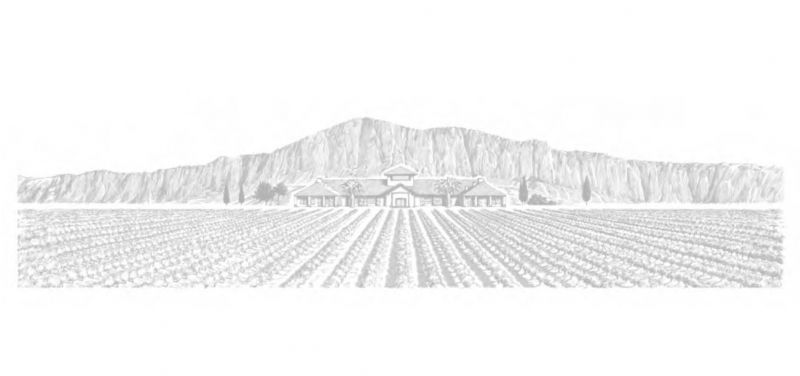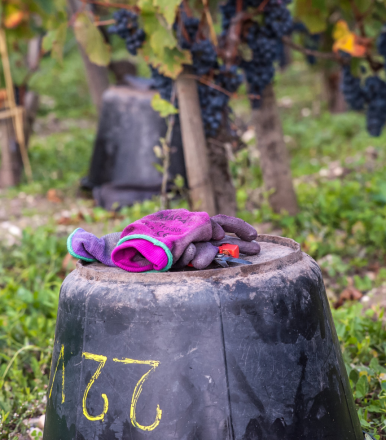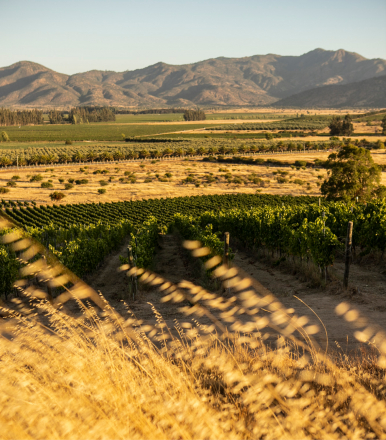
Read Los Vascos
Introduction
At Viña Los Vascos, agriculture is important to us but we do not only grow vines. We dream of transforming our vast territory into a balanced ecosystem where man and nature coexist in harmony.
We are free in spirit. We combine Chilean traditions with the know-how of DBR Lafite to produce wines in our image.
The Vineyard
Viña Los Vascos is located in the Central valley of Chile, in the Colchagua region, between the Andes and the Coastal Mountain Range, 200 km south of Santiago.
It is a secret that the locals have known for generations: the land of Viña Los Vascos has an ideal microclimate: plenty of sun and water, semi-arid soil, and no frost, thanks to the influence of the Pacific Ocean. The perfect conditions to produce exceptional wines.
Surrounded by mountains at the foot of Mount Cañeten, the property covers 3,600 hectares, 640 of which are planted with vines, making it one of the largest wineries in the region.
Located 150 m above sea level and only 40 km from the coast, the vineyard benefits from the cooling influence of the Pacific Ocean. This particular location between two major climatic influences – the cooling Pacific Ocean to the west and the Andes to the east – creates a microclimate with a strong contrast between hot, dry days and cool, wet nights.
The dramatic temperature difference between day and night can reach up to 30°C in the same day, which is particularly favourable to the slow ripening of our Cabernet Sauvignon.
The soil of Viña Los Vascos is of volcanic origin. Three main types can be distinguished: weathered granite, clay, and shale. The heart of the property, at the bottom of the valley, is made up of sand and clay alluvium left by the erosion of the neighbouring granitic hills; as well as Tosca, a very hard soil made up of volcanic ash that has been transported by the rivers to the plains and compacted over time.
Higher up, in the surrounding foothills, are the terroirs of El Mirador and Santa Lucia, where the granites are particularly suited to complex, long-lived wines. This is where we planted the vines to produce the grapes for the Cromas Grande Réserve wines.
The grape varieties of Viña Los Vascos are Cabernet Sauvignon (68%), Carmenère (9%), Syrah (8%), Chardonnay (5%), Cabernet Franc (2%), and Sauvignon Blanc (2%).
Due to the large plantings carried out in the early 1990s, the vineyard is divided between a group of plots with an average age of 15 years and another group of 40 to 50 years old. The oldest vines are 60 years old.
Viña Los Vascos relies on traditional growing methods. Drip irrigation is adapted to the strict needs of the vines and green harvesting is practised on the plots that require it in order to always meet a quality objective.
History
In the 18th century, a Basque family was the first to plant vines in this lush region of central Chile. When we acquired Viña Los Vascos in 1988, we were among the first European families to purchase a vineyard in the region.
Extensive studies were carried out to identify the best terroirs, the vineyards were restructured, and the bodega was restored to meet the new quality requirements for wine-making and ageing.
One Ecosystem
We are free in spirit but we do not forget our heritage. Our holistic approach embraces and protects everyone, from our short-legged sheep that eat the weeds without devouring the precious grapes, to our craftsmen who sharpen handmade knives to tend the vines.
The goal of Viña Los Vascos has never been to simply create a productive vineyard, but to develop a unique ecosystem that shows what our local nature and biodiversity can achieve when given the right tools.
The ecosystem of Los Vascos includes:
• A nursery where vine plants and rare species coexist, some of which are used for the production of medicinal plants.
• An olive grove that produces excellent quality olive oil.
• Several hectares of orchards and gardens, from which we use local produce to cook for our guests.
• Woods and forests of eucalyptus, cork oak, oak, and the native quillay, especially plantations of native trees and shrubs to preserve the local flora and fauna.
• A flock of sheep that maintain the pastures, produce natural fertiliser for the vineyard, and provide wool and meat.
• Horses that we traditionally breed and use for surveillance of the property, and to supervise the teams in the vineyard.
• Beehives spread over the property which are an excellent indicator of the quality of the ecosystem.
• Agricultural production of cereals and pulses.
• Several lakes and ponds, some of which are used as a water resource for irrigation. They are also key areas for attracting local birds for their nesting season.
Vinification
Viña Los Vascos has its own approach to winemaking, combining Chilean traditions with DBR Lafite’s heritage and expertise, without ever following trends.
For the red wines, a short pre-fermentation maceration – 20 to 25 days of vatting at 25 degrees – is followed by ageing in vats or barrels, depending on the vintage. For the whites, the vinification is carried out with a tight settling, a fermentation at low temperature – 15 degrees for at least 20 days – then an ageing on lees with stirring.
Proud of its ecosystem and its people, the community of Los Vascos is happy to share wines that reflect the attributes of their unique terroir.
Our commitment
Cultivating Independance
A vast estate with a remarkable wealth of biodiversity and teams committed to managing the vineyard in harmony with this ecosystem, Los Vascos is cultivating its uniqueness even further.
Los Vascos is certified by the Code of Sustainability of Wines of Chile, respecting highly compelling social, environmental, and qualitative norms both in the vineyard and in the winery.
All plant waste generated at the property (from pruning wood, grape stalks, and marc) is composted for fertilizer. The winery’s waste management system includes a BioFiltro, an earthworm-powered filtration system that processes wastewater removing up to 99% of contaminants in a matter of hours, yielding high-quality water to irrigate the vineyards.
Los Vascos is also committed to finding sustainable ways to use its energy. At the end of 2018, solar thermal tubes and a photovoltaic plant came into operation.
This Domaine joined the B Corp community in December 2023. To learn more, click here.
The Wines
Our wines are true to their Chilean heart, born in the wilderness of the Colchagua valley, but they are made in the spirit of DBR Lafite, combining ancestral know-how with the latest techniques to produce wines of great elegance and precision.
Our goal? To achieve a perfect balance between this strong local identity and what we have learned at DBR Lafite about finesse and precision.
The main grape variety is Cabernet Sauvignon, which is particularly suited to our terroir and also the emblematic grape variety of Château Lafite Rothschild.
But here, in Colchagua, it has turned into a different variety that we like to work with to reveal a new aromatic palette. The wines are made and aged in the Bordeaux tradition, and feature remarkable elegance and aromatic freshness.
“Le Dix”
Time Regained.
With Le Dix, whose first vintage celebrates ten years of Domaines Barons de Rothschild Lafite in Chile, we aspire to create a timeless icon from our oldest vines.
To make this blend of Cabernet Sauvignon and Syrah, we select the best grapes of the year. The Cabernet Sauvignon is sourced from our historic vineyard called “El Fraile” (the Monk), planted at high density on sands and silts more than half a century ago and whose genetics have been preserved thanks to the layering system. The Syrah comes mainly from El Mirador, the first vineyard we planted on the hillsides.
Aged for 18 months in oak barrels made by the “Tonnellerie des Domaines” cooperage in Bordeaux, Le Dix is a wine for long-term cellaring that will reveal its full potential with time.
“Cromas"
Colour is the language of nature.
Cromas is derived from the Greek word for colour. At Los Vascos, we see colour as the language of nature. Every tone, every shade, every nuance is a message here. As growers, years of careful observation have taught us to read the signs that nature sends us, to guide our daily actions and choices.
While exploring the foothills, we found a specific type of ochre granite that seemed particularly suited to planting new vineyards. The shallow granite soils and the good sun exposure of the slopes gave rise to well-balanced vines that today produce precise and elegant wines. The wines in our Cromas range are aged for 12 months in barrels. They reflect the know-how of our team and the potential of our terroirs and hillsides.
The Cabernet Sauvignon in our Cromas Grande Réserve was selected from plots in the foothills of Santa Lucia, where it benefits from optimal exposure and light intensity. The contrast between day and night temperatures is extreme in these vineyards, making the conditions particularly favourable for the slow ripening of our emblematic grape variety, with the period between veraison and ripening extending to 75 days. Cabernet Sauvignon is harvested late in the season, when the leaves begin to change colour and the estate takes on its vibrant autumnal hues.
Cromas Carmenère, with Chile’s signature grape variety, has captured the breadth and ruggedness of its environment, with the unique red hues of the Andes Mountains to the ocean beyond. Its dense, dark purple juices can be found like ink marks on the hands of our growers. Its aromatic palette is as wide and generous as nature itself.
It is on the rugged granite hills of the Coastal Mountain Range that our Syrah has found a home. The difficult conditions encourage the vines to reach their full potential and produce grapes of great complexity. The intense violet hues and fragrant aromas of violets are the distinctive elements of a great Syrah, and of our Cromas Syrah.
For Cromas Cabernet Franc, the grapes are grown on the sunny slopes of the foothills of the Santa Lucia vineyard, where the granite soils are covered with a layer of yellow-red clay that reveals the uncompromising personality of this delicate grape.
“Los Vascos Chagual"
Everything in nature is connected.
Chagual is the organic wine range of Los Vascos. The chagual (Puya chilensis) is a species endemic to the coastal region of Chile. Like this majestic plant, over two metres high and a model in terms of its contribution to its ecosystem, our organic wines originate from a harmonious relationship between the vineyard and the community of Los Vascos.
Chagual Cabernet Sauvignon is made from certified organic plots in the heart of our Peralillo vineyard. The soils are of medium depth and are made of sand and clay. Combined with the breeze from the near Pacific Ocean, they allow for the production of fresh and well-balanced grapes. In the winery, a 15-day maceration reveals the typicity of the grape variety while respecting its characteristic structure. Similarly, ageing in cement vats preserves the aromatic expression and freshness of the Cabernet Sauvignon.
Chagual Sauvignon Blanc is made from grapes grown in the coastal valley of San Antonio. Here, the soils of granitic origin benefit from good drainage and low nutrient content, forcing the roots to explore more deeply. These characteristics, combined with the influence of the Pacific Ocean less than 20 kilometres away, allow the grapes to ripen slowly, thus preserving their acidity and aromatic typicity.
With its herbaceous notes, freshness, and volume, Chagual Sauvignon Blanc reflects the authenticity of its coastal terroir.
“Los Vascos"
The expression of the grape variety.
The wines in our Los Vascos range are single varietal wines from the historic heart of our Peralillo vineyard. The soil of this valley floor is composed of sand and clay alluvium and “tosca”, a hard rock made of compacted volcanic ash.
The grapes are picked early in the morning, fermented at low temperature, and then aged in stainless steel tanks to preserve the maximum purity of the fruit. These are fresh and juicy wines, with a touch of sophistication brought by the partial ageing on lees.
Los Vascos Sauvignon Blanc is sourced from the coldest parts of our vineyard, where the grapes reflect the typicity of this variety. It is a very expressive wine with aromas of peach, pineapple, pear, and lychee, mixed with citrus and chamomile. On the palate, the wine has tension and length, with a good balance between acidity and volume.
Los Vascos Chardonnay has a pure and fresh style. The absence of malolactic fermentation gives it a pleasant acidity and the partial aging process on the lees gives it a nice smoothness on the palate. It is well-balanced, expressive, and fruity, with aromas of melon, custard apple, and physalis, as well as hints of zucchini and pumpkin.
Los Vascos Rosé is a blend created from young Grenache, Syrah, and Mourvèdre vineyards planted on the hillsides of the Santa Lucia vineyard. This rosé wine, with its delicate pale pink colour, is an aromatic explosion of red fruits, pomegranate, peach…. with a delicate floral touch. On the palate, it is lively, fresh, and fruity, with silky tannins, and good persistence.
Los Vascos Cabernet Sauvignon is vinified in the Bordeaux style, but without barrel ageing, to capture the essence of the variety planted in Colchagua. The nose bursts with aromas of red fruits such as plum and cherry, interspersed with notes of ripe strawberries, nutmeg, cocoa, thyme, and black pepper. The palate is ample, with ripe tannins, and a beautiful concentration and persistence.
 Read next
Read next



